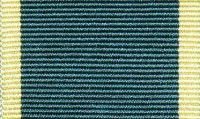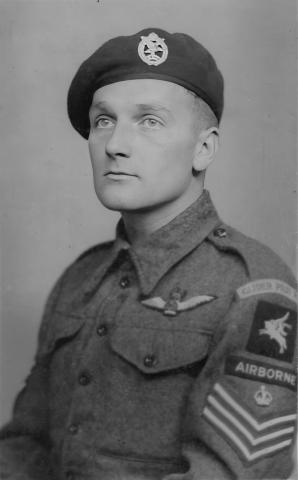William Henry Wastell was born 8 August 1919 Charlton Greenwich. He was working as a Laboratory assistant and joined the 34th AA Battalion Queens Own Royal West Kent Territorial Army. His Service No being 2041969 in 1937 and was taken on strength in the Royal Engineers 1 September 1939 on the outbreak of WW2.
This became re- designated as the Royal Artillery in 1940 and he served with them until 1942 William served in & around the Kent area, searchlights needing to be moved around roughly every three months. 1940-1941 William moved to Search Light Training Depot Hadrian's Camp Carlisle. He served June 1941-January 1942 with The Royal Scots st Roxburghshire, then from January 1942-July 1942 served with the Orkney Defence Force. William had wanted to fly, since working on the searchlights in the area of Biggin hill and watching the Spitfires (his Dad having been unwilling to sign the papers) he saw a recruiting order to transfer to the Glider Pilot Regiment. His application being successful days before his 21st Birthday August 1942.
After flying training in Tiger Moths, Miles Magister, Hotspur Gliders and eventually Horsa Gliders. Gaining his army flying wings in March 1943. As a 1st pilot William is posted to G Sqn, 24 Flt at RAF Fairford with the 1st Airborne Division. There's not many flying hours the tugs being busy flying sorties and supplies it wasn't until Sunday 17 September that William (Bill) in Horsa 437 carrying a jeep, trailer, heavy motorcycle and 7 Royal Engineers towed by crew of 190 Sqn RAF in a Short Sterling heading for Landing Zone 'Z' at Wolfheze. Being the first day the weather was fine and hardly any flak, a few Horsa Gliders were spotted in the sea but all crew seemed to be safe. Once landed having been surprised by occupants of a nearby Asylum rushing towards them, the Asylum having been on the end of pre bombing raids, it being thought the Germans were holed up in the grounds.
William rendezvous with other Glider Pilots and stays in the vicinity of Wolfheze for the night, awaiting the second lift from the UK the following day the 18 September. When they move forward they are only able to reach the Hartenstein Hotel and William is, (according to his Glider Survey report) dug in by the tennis courts. He goes on a Glider patrol which takes them to the Bakery on Paul Krugerstraadt. There must have been some sort of activity in the area as Bill states 'he dug in.' Eventually returning to the Hartenstein where he is hit in the foot by a mortar and carried into the cellar of the Hartenstein on the Sunday the 24 Sept the 8th day, before being taken by jeep on the 25 September to a first aid post now in the hands of the Germans and becomes a POW. It is unclear which first aid post but think it was the Schoonoord Hotel and whether or not he is taken to the Queen Elizabeth is also unclear. What is clear is he is taken to the Airborne Apeldoorn Hospital until being taken by first aid cattle car to Stalag X1B at Fallingbostal on the 6 October 1944. Some of the POW's are moved by cattle carriages to Stalag V11C at Sagan. On the 8 Feb 1945 William and the other POW's were to go on a 380 mile march from Stalag V11C at Sagan This was to be one of many of the terrible marches through a very harsh winter, little or no food and men unable to carry on, with many dying of dysentery.
During the march William and a fellow Glider Pilot Walter Mullett, also of 24 Flight G Sqn were to attempt an escape through a hedge. Unfortunately they were spotted running through a cemetery, by an old woman, likely she had reported them. They boarded a carriage on a siding but when they poked their heads out being blinded by the sun, they were spotted and re arrested. Noting their wings, they were very lucky not to be shot as it was around the time the RAF had bombed Dresden and Hitler had ordered RAF persons were to be shown no mercy. They managed to convince their guards they had escaped during a march, and were taken back. Their German commander none too pleased to have his bed and board interrupted. March 1945 arriving at Stalag 1XB Bad Orb. When they were liberated in early April 1945 by the Americans Bill and Walter went 'over the wire' rather than wait to be returned to UK, making their own ways to Brussels being flown home and arriving in the UK on the 10 April 1945. Bill wasn't to return home to the family until July 1945 and neither did he fly again up until his 'de mob' 1946/47.
William having recuperated in Bournemouth, it is here that he takes up a job working in his Aunt and Uncles, (who are sister and brother) Cafe. His Uncle wants to make him the Manager, but his uncle being an alcoholic, (possibly from his time in Service WW1) he decides it would mean his Uncle would just spend his time drinking, so he leaves Bournemouth and goes to stay for three months with his Sister Joyce in London.
Fed up with 'civil street' for a year and after a night on the tiles, waking up with very little money in his pocket, he signs on once again into the Queen's Own Royal West Kents, with a new Service No. 21010146. He's in Aldershot and sees a poster recruiting again for the Glider Pilot Regiment, within no time, he is back in the Glider Pilot Regiment, by the skin of teeth, as he was initially told he was too short to fly a glider. Oh! to be a fly on that wall! It isn't until February 1948 before he is taken on strength with the Glider Pilot Regiment as there are no uniforms available, all having been sold on the black market. William has to revert to Cpl from Staff Sergeant. He has to complete flying refresher training and again earns his Sgt stripes. He was a Glider Pilot up until 1957 when it became the New Army Air Corps known as today and until his last military flight, the 18 June 1971. Flying light aircraft the whole of his service life. The Auster Aircraft for 14 years, during which he had two tours in Malaya 1949-1952 and 1958-1960. BAOR with stints in between at HQ Middle Wallop, out post at RAF Hucknell. A Qualified Flying Instructor on both the Auster and the Beaver.
William proudly wore his "para wings", having completed a couple of courses and even joined the Para recruiting team in August 1949 at Netheravon. His daughter recalls him saying "if I'm going to fly 'em, I'm gonna learn how to jump out of 'em!" Although actually, light aircraft didn't have parachutes! He even went to Arnhem in September 1949 with the Paras, attending a wedding of an unknown (sadly) which took place in Arnhem, with RSM Lord in attendance. Willie affectionately known as in his AAC days by Generals & lower ranks alike, lived to the ripe age of 92 passing in February 2012 and missed by his elder daughter Anne & younger daughter Jane. His son having sadly passed in 2019. He retired very shortly after his service life, Settling down in Christchurch, Dorset. His daughters recall him saying "he had, 'no regrets,' he'd had a good life!"
Submitted by Anne Gardner (daughter).
Read More






















































Latest Comments
There are currently no comments for this content.
Add Comment
In order to add comments you must be registered with ParaData.
If you are currently a ParaData member please login.
If you are not currently a ParaData member but wish to get involved please register.